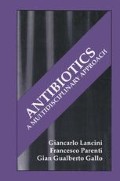Abstract
The relationship between antibiotics and their producer microorganisms is a matter of lively discussion among specialists. Why is the ability to produce a great variety of antibiotics limited to relatively few classes of microorganisms? How can a producer organism survive in the presence of a substance toxic to it? What is the “natural” function of antibiotics, i.e., what evolutionary advantage do they confer to the producer? There are no generally accepted answers to these questions.
Access this chapter
Tax calculation will be finalised at checkout
Purchases are for personal use only
Preview
Unable to display preview. Download preview PDF.
Reference
Cundliffe, E., 1989How antibiotic-producing organisms avoid suicide Annu. Rev. Microbiol. 43:207.
Davies, J., 1990What are antibiotics? Archaic functions for modern activities Mol. Microbiol.4:1227.
Demain, A. L., 1989, Functions of secondary metabolites, in Genetics and Molecular Biology of Industrial Microorganisms ( C. L. Herschberger, S. W. Queener, and G. Hegeman, eds.), pp. 1–11, American Society for Microbiology, Washington, D.C.
Laskin, A. I., and Lechevalier, H. A. (eds.), 1988, Handbook of Microbiology, 2nd ed., Vol. 9, Part A, CRC Press, Boca Raton, Fla.
Martin, J. F., and Liras, P., 1989, Organization and expression of genes involved in the biosynthesis of antibiotics and other secondary metabolites, Anna. Rev. Microbiol. 43: 173.
Stone, M. J., and Williams, D. H., 1992, On the evolution of functional secondary metabolites, Mol. Microbiol., 6: 29.
Vining, L. C., 1990, Functions of secondary metabolites, Anna. Rev. Microbiol. 44: 395.
Author information
Authors and Affiliations
Rights and permissions
Copyright information
© 1995 Springer Science+Business Media New York
About this chapter
Cite this chapter
Lancini, G., Parenti, F., Gallo, G.G. (1995). Antibiotics and Producer Organisms. In: Antibiotics. Springer, Boston, MA. https://doi.org/10.1007/978-1-4757-9200-3_9
Download citation
DOI: https://doi.org/10.1007/978-1-4757-9200-3_9
Publisher Name: Springer, Boston, MA
Print ISBN: 978-1-4757-9202-7
Online ISBN: 978-1-4757-9200-3
eBook Packages: Springer Book Archive

